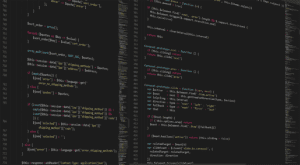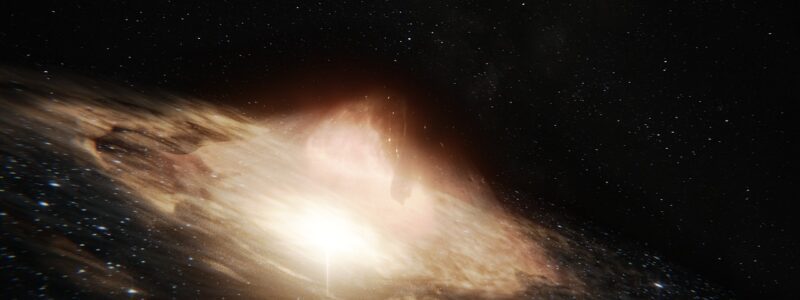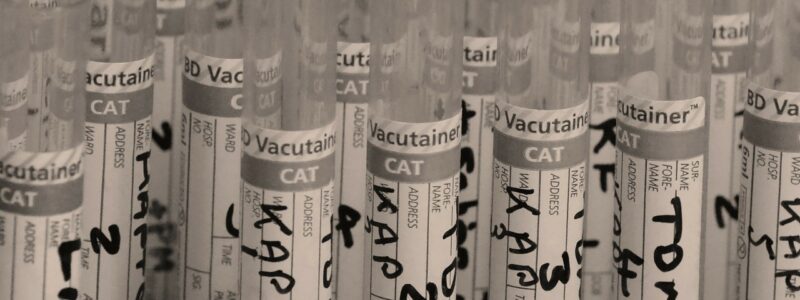How Did Life Go Live
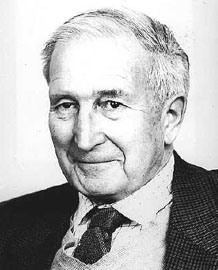
Antony Flew – By عبد الله الصيدلي at Arabic Wikipedia – Transferred from ar.wikipedia to Commons., Public Domain, Link
How Did Life Go Live
The question, “How Did Life Go Live” has led many scientists, theologians, and laypersons to different conclusions. Antony Flew came to the conclusion that God must exist in order for life to exist.
Antony Flew was one of the world’s leading atheists, frequently engaging theists in intense debates concerning the existence of God.
Then during the beginning of one such debate in 2004, Flew amazed the viewing public by announcing he now believed in God.
This was a revelation of monumental proportions. Flew indicated he would always follow where the evidence leads and felt with the advancement of science the evidence now led to a belief in God.
One of the reasons he changed his mind was the emerging science regarding abiogenesis – or the science regarding the beginning of life. He announced his realization there was no satisfactory naturalistic explanation for how living matter might arise from nonliving matter.
This produced an outcry from the atheistic community. Richard Dawkins claimed Flew was appealing to the “god of the gaps.” Flew wrote in his book God and Philosophy,
I am delighted to be assured by biological-scientist friends that protobiologists are now well able to produce theories of the evolution of the first living matter and that several of these theories are consistent with all the so-far-confirmed scientific evidence.
However, he also noted that the age of the universe gives too little time for these theories of abiogenesis to be possible. Rather than give a biological refutation to Dawkins’ objections, he relies on philosophical considerations in his answer.
The Purpose-Driven Organism
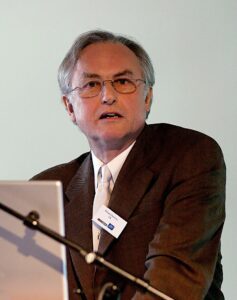
Richard Dawkins – By Matthias Asgeirsson from Iceland – Richard Dawkins on Flickr, CC BY-SA 2.0, Link
Flew analyzes recent philosophical considerations on the origin of life. He considers Richard Cameron who states that life is teleological; it possesses intrinsic goals or purposes. Life defined in teleological terms describes it by the purpose it serves rather than how it originated.
Contemporary biologists, philosophers of biology and workers in the field of ‘artificial life’ have yet to produce a satisfying account of what it is to be alive, and I defend the view that Aristotle can help us fill this gap. … Aristotle did not hold life and teleology to be coextensive simply by chance, but defined life in teleological terms, holding that teleology is essential to the life of living things.
The origin of self-reproduction is a second consideration that must be explained. Flew notes the distinguished philosopher John Haldane notes that origin-of-life theories,
do not provide a sufficient explanation, since they presuppose the existence at an early stage of self-reproduction, and it has not been shown that this can arise by natural means from a material base.
Certainly, not every philosopher believes the case for a metaphysical origin of life is likely. David Hume felt the life-sustaining capacity of the universe does not indicate there is any intelligence behind this order. Richard Dawkins believes that the extraordinary order of the universe does not necessarily suggest a creator. David Conway summarizes the two major problems for a natural explanation of life.
The first challenge for the development of a theory for the non-theistic development of is to explain,
the very first emergence of living matter from non-living matter. In being alive, living matter possesses a teleological organization that is wholly absent from everything that preceded it.
The next hurdle is to explain,
the emergence, from the very earliest life-forms which were incapable of reproducing themselves, of life-forms with a capacity for reproducing themselves. Without the existence of such a capacity, it would not have been possible for different species to emerge through random mutation and natural selection. Accordingly, such mechanisms cannot be invoked in any explanation of how life-forms with the capacity first ‘evolved’ from those that lacked it.
Conway felt that these two hurdles
provide us with a reason for doubting that it is possible to account for existent life-forms in purely materialistic terms and without resource to design.
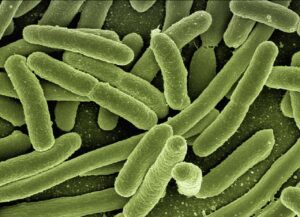
Image by Gerd Altmann from Pixabay
The fact that life has not been manufactured in the modern molecular biology laboratory lends credence to the difficulty associated with producing the first life forms. Darwin and other biologists of the nineteenth century felt a bacteria was only a pocket of “protoplasm” with little complexity or organization. The microscopes of Darwin’s day could only show bacteria as small specks against a much larger background consistent with their assertions.
Modern biology tells a completely different story. We now know even the simplest bacteria is a complex factory of interdependent organelles and complex machinery more complex than any factory anywhere in the world. Many thousands of research articles are published every year concerning how this factory works, with each new year bringing new orders of complexity.
It is no wonder even the simplest bacteria has not yet been made from shelf chemicals, even in the most sophisticated molecular biology laboratories in the world. Flew made this observation and asks the simple question as to how life could originate in a scum pond when it cannot be made using all the knowledge we have today.
Origin of Information
More challenges await those seeking to explain the first emergence of life, not the least of which is to explain the natural order of information. The mathematician David Berlinski discusses the narrative concerning information flow in the average cell.
The genetic message is written in DNA molecules that exist in every cell. The genetic message is fir copied from DNA to RNA in a process called “transcription.” Following this, there is a translation process where the RNA message is read by the cell and converted into amino acids which are then assembled into proteins.
The remarkable nature of this phenomenon may be understood when looking at the word “code.” Berlinski notes,
By itself, a code is familiar enough, an arbitrary mapping or a system of linkages between two discrete combinatorial objects. The Morse code, to take a familiar example, coordinates dashes and dots with letters of the alphabet. To note that codes are arbitrary is to note the distinction between a code and a purely physical connection between two objects. To note that codes embody mappings is to embed the concept of a code in mathematical language. To note that codes reflect a linkage of some sort is to return the concept of a code to its human uses.
Then he asks,
Can the origins of a system of coded chemistry be explained in a way that makes no appeal whatever to the kinds of facts that we otherwise invoke to explain code and languages, systems of communication, the impress of ordinary words on the world of matter?
Philosophers were not the only ones who had difficulty with conceptualizing how life might have started. The fantastically complex thing we know as life is certainly present in abundance here on earth. The only problem is that origin-of-life theorists don’t have a clue as to how life started here.
To illustrate this ignorance, Andy Knoll who is a professor of biology at Harvard and writer of Life on a Young Planet: The First Three Billion Years of Life, notes,
If we try to summarize by just saying what, at the end of the day, we do know about the deep history of life on Earth, about its origin, about its formative stages that gave rise to the biology we see around us today, I think we have to admit that we’re looking through a glass darkly here. We don’t know how life started on this planet. We don’t know exactly when it started, we don’t know under what circumstances.
Another scientist, Antonio Lazcano who is president of the International Society for the Study of the Origin of Life, reports,
One feature of life, though, remains certain: Life could not have evolved without a genetic mechanism – one able to store, replicate, and transmit to its progeny information that can change with time. … Precisely how the first genetic machinery evolved also persists as an unresolved issue.
John Maddox, the editor emeritus of the prestigious journal Nature, writes,
The overriding question is when (and then how) sexual reproduction itself evolved. Despite decades of speculation, we do not know.
Finally, Gerald Schroeder points out the obvious that conditions that might be favorable to life still do not explain how life started.
The Nobel Prize-winning physiologist George Wald famously noted,
we choose to believe the impossible: that life arose spontaneously by chance.
Wald then would go on to note that there must have been a Designer – a pre-existing mind which he characterizes as the matrix of physical reality, composed the physical universe,
How is it that, with so many other apparent options, we are in a universe that possesses just that peculiar nexus of properties that breeds life? It has occurred to me lately – I must confess with some shock at first to my scientific sensibility – that both questions might be brought into some degree of congruence. This is with the assumption that mind, rather than emerging as a late outgrowth in the evolution of life, has existed always as the matrix, the source, and condition of physical reality – that the stuff of which physical reality is constructed is mind-stuff. It is mind that has composed a physical universe that breeds life, and so eventually evolves creatures that know and create: science -, art-, and technology-making creatures.
Finally, Flew goes on to say that,
The only satisfactory explanation for the origin of such “end-directed, self-replicating” life as we see on earth is an infinitely intelligent Mind.
The Typing Monkeys as Solution to How Did Life Go Live

Image by Karen Arnold from Pixabay
The “monkey theorem” is the idea that given enough time and enough monkeys banging on a typewriter (or computer keyboard), eventually, they would type out one of Shakespeare’s sonnets. This idea tries to defend the possibility of the emergence of life arising through natural mechanisms by blind chance.
The British National Council of Arts actually tried a variation of this experiment. The put a computer into a cage with six monkeys for a month and allowed the monkeys to “type” on the computer. The monkeys eventually produced fifty pages of typed “information” – but not a single word. The experiments noted that this was the case even though the shortest word in English is the word “I.” A word is only a word if there is a space on either side of it, so in order for an “I” to be a word, it would need to have two spaces: ” I “.
Since the English language has 26 letters and various symbols (such as spaces and hyphens), there are 30 characters that are used to type out English. To produce the simplest word ” I ” would then be a probability of 30 times 30 times 30 or 27,000.
Gerald Schroeder is an Israeli scientist who writes about science and religion. He noted,
All the sonnets are the same length. They’re by definition fourteen lines long. I picked the one I knew the opening line for, “Shall I compare thee to a summer’s day?” I counted the number of letters – 288 in the sonnet. What is the likelihood of hammering away and getting 488 letters in the exact sequence as in “Shall I Compare Thee to a Summer’s Day?”? What you end up with is 26 multiplied together by 488 times – or 26 to the 488th power. This turned out to be 10 to the 690th power.
The number of particles in the universe – not grains of sand, I’m talking about protons, electrons, and neutrons – is 10 to the 80th. Ten to the 80th is 1 with 80 zeros after it. Ten to the 690th is 1 with 690 zeros after it; There are not enough particles in the universe to write down the trials; you’d be off by a factor of 10 to the 600th.
If you took the entire universe and converted it to computer chips – forget the monkeys – each one weighing a millionth of a gram and had each computer chip able to spin about 488 trials at, say, a million times a second; if you turn the entire universe into these microcomputer chips and these chips were spinning a million times a second producing random letters, the number of trials you would get since the beginning of time would be 10 to the 600th. You will never get a sonnet by chance. The universe would have to be 10 to the 600th times larger. The the world just thinks the monkeys can do it every time.
Flew notes that if the theorem would not work with a single sonnet, then, of course, it’s simply absurd to suggest that it could somehow produce the information contained within DNA.
Summary to How Did Life Go Live
The suggestion that life could come about naturally was one of the deciding factors leading Antony Flew to become a theist – to believe in God. His answer to the question, “How Did Life Go Live” made him believe in the existence of a Creator. He understood through probability theory that abiogenesis was impossible.
You do not need to be a molecular biologist to recognize the absurdity of such a suggestion. The problem is that there is much, much more information contained within DNA than with a small Shakespeare sonnet – to come up with that information would be impossible.
We will next look at how the universe, groups of galaxies, galaxy, supernovae, neutron stars, black holes, our solar system, our planet, and multiple physical laws of nature are set to extraordinary tolerances in order to allow humans to be here.

